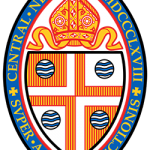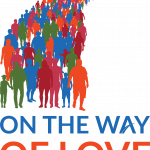image above used with permission of the Church of the Advocate, Chapel Hill, North Carolina
by the Rev. John R. Martinichio, Secretary of Convention
In our Baptismal Covenant we promise that we will “seek and serve Christ in all persons, loving our neighbors as ourselves” and “respect the dignity of every human being.” We know that each one of us is made in the image and likeness of our God. We strive to accept one another as God intends. In God’s kingdom there is nothing that separates us and in God’s eyes we are all equal. This is one of the reasons at funerals we use a pall to cover the casket or urn. No matter what the cost of the container we are placed in, we are all equal in God’s eyes. The white reminds us of the new life received at Baptism and the new life gained through death.
As our world changes, people are expressing themselves in ways that may be new to some of us. To learn about some of these changes, back in June the bishop’s staff participated in a presentation by Tyler Sliker, a counselor at Vera House in Syracuse, on current language and issues related to the queer and trans community and how we can be allies with this community. Tyler introduced us to current practices around pronouns, realizing that this language continues to change.
At our upcoming Convention, your name tag will have the usual information of name, parish and city, and now you will have the option of adding a small sticker that lets others know the pronouns you’d like them to use when referring to you. At first all this, being new, may seem a little uncomfortable. Until our staff’s June training, I never really gave it much thought myself. I even wondered why we need to do this. I think it all goes back to those promises that we have all made as brothers, sisters, and siblings in Christ. It is about valuing and expressing ourselves as God made us and encouraging others to do the same. You might have even noticed that some of the staff have placed their pronouns on their email signature. These practices allow us the space to have conversations about gender identity and expression that give us opportunities to learn, as the staff did that day.
How do you identify yourself? Common pronouns we use are she/her/hers/herself, he/him/his/himself, and they/them/theirs/themself (or themselves). One set of pronouns that was new to me was: ze/zir/zirs/zirself or ze/hir/hirs/hirself. Like they/them/theirs, we may use these pronouns when we don’t identify with “traditional” gender expressions. I think it is important that we always ask someone for what pronouns they use. By using the appropriate pronouns, we certainly show our love and to our brothers, sisters, and siblings.
We do know that gender identity, gender expression, sex assigned at birth, who we are physically attracted to, and who we are emotionally attracted to does not always fit into “conventional” models. We want to be respectful of each other and we do so by the language we use. We want to use their correct pronoun, their correct name, we do not want to assume their identity or anything else about them. It is always best to have a private conversation with them so you can learn more.
Through our visioning process we are listening to different voices and want to be sure that each member of our community is heard, and that nobody’s voice is silenced. It might seem like a small step, but it has a large and meaningful impact.
For more information, I encourage you to read this article by the Rev. Lisa Fischbeck on the Episcopal Church Foundation’s Vital Practices blog: “Pronoun Buttons: A Sign of Welcome,” or check out myprounouns.org.
The Rev. John R. Martinichio
he/him/his
Secretary of Convention



[…] Especially with our Learning Communities Initiative, we’ve found that living into God’s invitation to love often means trying new things. At this Convention, you’ll have the opportunity to try two new things. First, when you pick up your Convention nametag, you’ll have the option to add a sticker with your pronouns. We hope that this new practice will contribute to a Convention community that is hospitable to people of all gender expressions. You can learn more about this practice in this article by our Secretary of Convention, the Rev. John Martinichio. […]
[…] like delegate Katelynn Roffo of St. James’, Skaneateles were available to help others understand the new practice. Photo by Jim […]